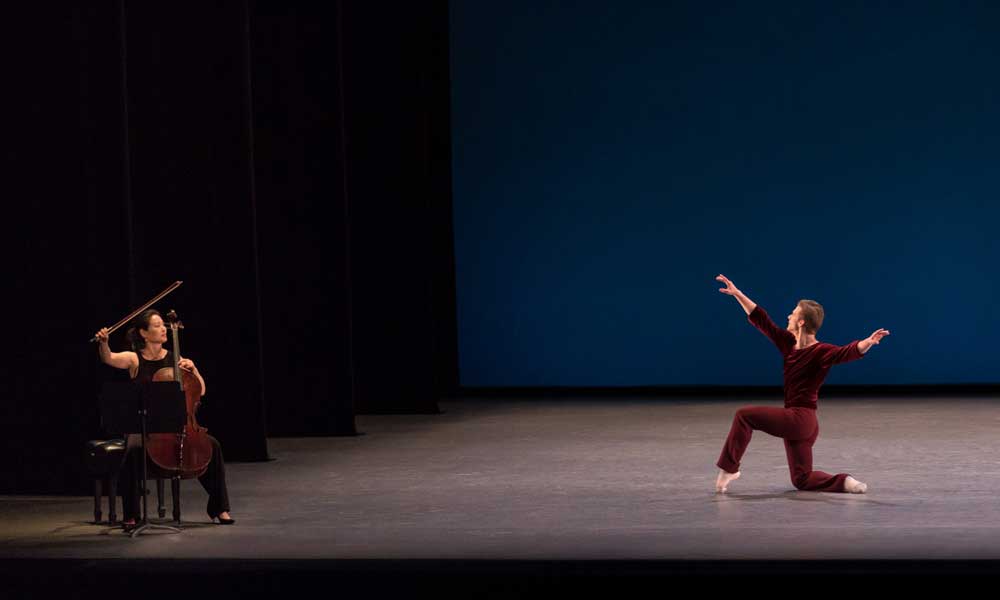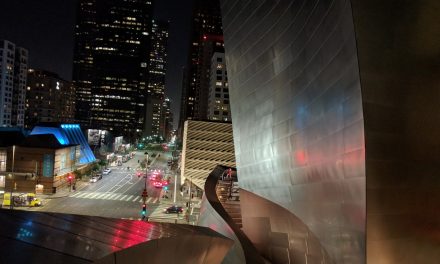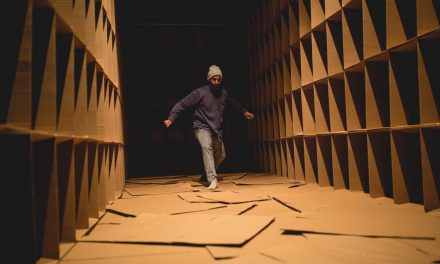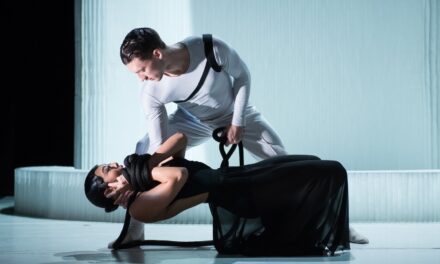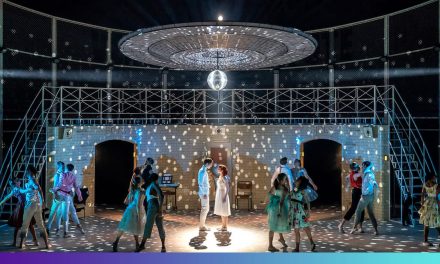On October 19, 2018, The Colburn Dance Academy, at Zipper Hall, hosted See The Music, Hear the Dance (G. Balanchine) and led by Dean Jenifer Ringer and Associate Dean James Fayette, former principal dancers of the New York City Ballet.
This Suite of Dances by Jerome Robbins personified the legacy of brilliance that was the era of Balanchine and Robbins. Johann Sebastian Bach’s artful Six Suites for Solo Cello, four of which were so beautifully played by Emma Lee, was a type of Pas de deux (dance for two) with Dancer and Cello. The brilliant, spirited and musical Daniel Ulbricht, principal dancer with New York City Ballet, performed in place of Joaquin De Luz. The first few strains, turned from unease to instant affection These suites take not only lyricism, a relaxed brilliant style of technique, but a playfulness, generosity, intelligence and spirit that reflects back to the inspiration of Robbins.
As the lights went down at Zipper Hall this special evening unfolded. The First Movement began with the lyrical strains of the cello, and a simple lilting walk by Ulbricht, which then led to a swirl and relaxed pirouette with limb extended, exposing the control and long line of leg and foot that can only personify the dancer’s technical strength and prowess. The piece then grows and breathes as if it were our oxygen, our life. Even though the technique is traditional, the artistry of the choreography, the communication and the process of unfolding made each movement appear and disappear as if never done before. The dancer’s breathing, arms, legs and feet, a tilt of the head, all were breathtaking, one felt each moment, hoping it would never end. It continued to grow without effort, but the intelligence and love, the communication with the music, that emanated from this, too rarely done piece, left the audience’s heart pounding
The Second Movement, in typical Robbins style didn’t let us rest, but introduced us to a mischievous gigue, which included a summersault in the middle of a stylish and playful court dance. Yet again surprising us, when getting a bit carried away, Ulbricht pulled himself up by his collar to continue his wonderful allegretto. His lovely energetic youthful quality allowed an engaging sense of humor that the audience responded to in like kind, and with another quick summersault, a stop and hitch of hip left and right, he went back into his sautés cabrioles and assemblés to the end that piece.
The Third Movement, a Sarabande, slow stately 17th century dance form from Spain, shows remarkable artistry and restraint. This piece allows a quiet breathing moment for the dancer; perhaps a time to reintroduce one’s heart to the touching strains of Bach’s genius. A lift of ones outstretched arm then another in circular movements leads to extended legs and tilting upper body. The purity, the fearless reverence, draws to an end as it began, with a reaching towards the heavens.
The Fourth Movement is structured like an Irish reel, patterning the movements in a line up and down stage. Then breaking the strict line, Ulbricht begins circling the stage, we are again surprised when he inserts free-wheeling side steps reminiscent of the Russian Sailors Dance, and the Charleston. It ends with dervish-like spins in arabesque, shifting the leg front, then gesturing to the cellist that he’s done. He then cartwheels to the floor, sits back, smiles at the cellist and completes the set to rousing applause. The audience witnessed a thrilling and classic moment in dance.
In the discussion afterwards, moderated by Jennifer Ringer, Daniel Ulbricht told a wonderful story of how fortuitous art can be. Jerome Robbins, who had had a fallow period, not having choreographed for awhile, happened to meet Baryshnikov at a gathering who asked him if he would like to someday go back into the studio. Robbins was a bit evasive, but two weeks later, he called Misha and they met to work. And what came out of that work was the incredible Suite of Dances. Eventually Daniel Ulbricht worked with Baryshnikov on the pieces and the valuable notes Misha gave him made it clear that the genius of Robbins and Baryshnikov would be passed down through time to the young artists of the future. Ulbricht was one of those young dancers who is now passing on his wisdom to dance hopefuls, as well as working with under-served communities. His talent extends to mentoring and teaching all over the country, which includes the enthusiastic students of the Trudl Zipper Dance Institute led. Thank you Dean Ringer and Fayette. What a special evening it was.
For information on the Trudl Zipper Dance Institute, click here.
Featured image: Emma Lee, Daniel Ulbricht in Suite of Dances – Photo courtesy of the Trudl Zipper Dance Institute.

